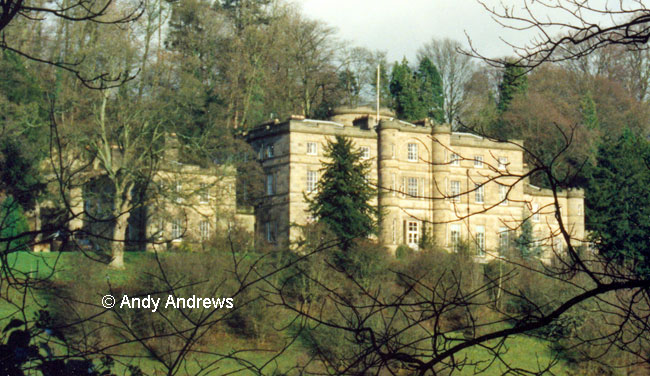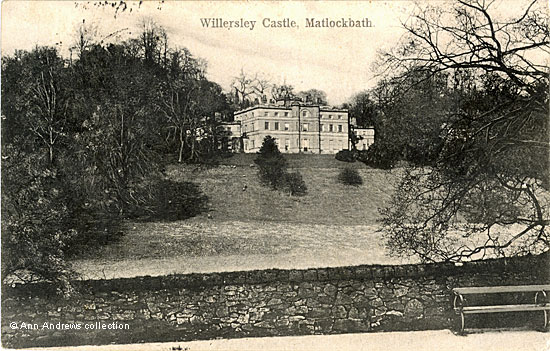|
Images Index> Matlock, 20th and 21stC Images> This page |
| Matlock: Willersley Castle, early 1900s |
| Matlock : Twentieth Century Photographs, Postcards, Engravings & Etchings |
|
|||
At one time a single seat was next to the gates but it was replaced by the double version (bottom right in the above picture), which was in situ for many years though it was finally removed when the road was widened in the 1960s[1]. The seat can also be seen in the Southern Entrance to the Dale, linked on the right. The rare image below is of Willersley Rocks or Scarthin Lodge, which appears to have been built in the Gothic Revival style with its windows and doorway having Perpendicular Gothic arches; indeed, the windows look rather like church windows. There are also battlements around the roof line, unlike the softer Georgian architecture of Willersley's other Lodge. Conservationists would have fought hard to preserve this building today.
The house was built after a huge rock was removed. According to Horace Weir, writing in 1910, Arkwright had to spend something like £3,000 on the removal work before he could start to build. Weir also quoted a supposedly little known comment from the great man. Apparently a young man of "noble birth" was overheard remarking on the great man's lack of well known ancestors. Arkwright's response was that he could follow his own line back equally as far as his critic's. "Noah," he is reputed to have quipped, "was the first Ark-wright"![3] In September 1905 Willersley's lawns were filled with the Arkwright family's tenants who had been invited to the celebrations marking the coming of age of Mr. Richard Alleyne Arkwright, the heir to the estate. Great preparations were made for the event and a large marquee was erected on the paddock in front of the Castle. Seven hundred of the tenantry from Cromford, Matlock, Wirksworth, Bonsall, Middleton and the Marple estate sat down to dinner (now known as lunch). During the afternoon the numbers swelled to eleven hundred as school children joined the tenants and they were all served tea[4]. |
|||
Enlargement of a section the top image |
|||
 Willersley, Winter 2001. Around a hundred years later. Willersley is almost impossible to see when the trees are in leaf from this position today. |
|||
|
1. and 2. "Willersley Castle, Matlockbath". Boots Cash Chemists "Pelham" Series. Posted 4 May 1907 in Matlock Bath and sent from Lilly to her Aunt A, a Miss Pinder. Postcard in the collection of and provided by and © Ann Andrews. 3. "The Tors, Entering Cromford". An enlargement of a section of the postcard, published by A. J. Newton of Post Office Cromford and posted in 1907. © Kenneth Smith collection 4. Photograph of Willersley Castle © Andy Andrews. Researched, written by and © Ann Andrews. Intended for personal use only. |
|||
References (coloured links are to transcripts and information elsewhere on this web site): [1] There are some photographs of the road widening in Michael Fay's "The End of a Long and Winding Road". Scroll down to the section on "Difficult civil engineering work". [2] "History, Topography and Directory of Derbyshire", (1895) by T. Bulmer and Co. [3] "Derbyshire Advertiser and Journal", 1 January 1910. Willersley Castle, Cromford. By Horace Weir. [4] "Derby Daily Telegraph", 2 September 1905. Fete at Willersley Castle. [5] "Derbyshire Times", 8 September 1923. Willersley's Future. Death Duties' Toll on Cromford Estate. This was the report of a meeting, held in Cromford School, where Captain Arkwright spoke to the tenants and explained the situation he faced. [6] "The
Times", 7 Nov, 1923. To be let, furnished or unfurnished. |
|||









